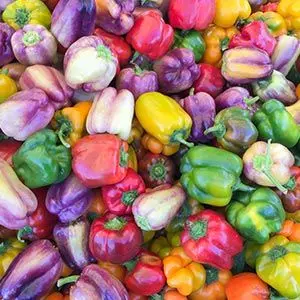Bell Peppers: Does Your Pet's Diet Include This Disease-Fighting Food?
Technically a fruit, this crunchy treat comes in different colors and is rich in flavonoids, vitamin C and other antioxidants. Have you tried adding it to your pet's meals? Here's how to share it with them safely.

STORY AT-A-GLANCE
- Bell peppers are rich in flavonoids, carotenoids and phenolic compounds that may help improve health through their antioxidant properties, which may help mitigate stress and reduce risk of degenerative diseases
- They contain the flavonoids apigenin and luteolin, which are known for their antioxidant and anti-inflammatory activities and may help reduce the risk of chronic diseases, such as cardiovascular diseases, cancer and Type 2 diabetes
- Capsanthin, which is mostly found in red bell peppers, is a carotenoid that gives the fruit its red color and may offer numerous benefits such as anti-inflammatory, antitumor, antidiabetic and antiobesity properties
- Lycopene is another carotenoid found in red bell peppers that may be beneficial during the treatment of canine osteosarcoma
- Bell peppers can be given raw to pets, though some smaller breeds may find the outer skin a bit tough and difficult to chew, so steaming the bell peppers may help
Editor's Note: This article is a reprint. It was originally published March 30, 2023.
Crunchy, colorful and mildly sweet, bell peppers (Capsicum annuum1) are one of the most versatile garden harvests you can have in your refrigerator. Due to their distinct (but not overpowering) flavor, they are popularly used in cooking, although you can also enjoy them raw, such as in salads, where they impart sweetness and a fresh, satisfying crunch with every bite.
A wonderful thing about bell peppers is they can also be shared with pets, who can reap the same benefits you do from these fruits. They can be added to your pet's nutritionally balanced, species-appropriate homemade diet or given as a treat. Using chopped bell peppers as a topper to your pet's meal can also add color and a crunchy texture to their foods. Keep on reading to learn more about the benefits of bell peppers for pets.
What Are Bell Peppers and What Benefits Can They Offer?
The humble bell pepper is part of the nightshade family (Solanaceae) and is a close cousin of tomatoes, eggplants and potatoes.2 They’re named after their bell-like shape and are characterized by their smooth exterior and bright colors — red, yellow, green, orange, purple and even brown or black.3
Bell peppers are a great source of various nutrients and are a particularly rich source of vitamin C. A 100-gram serving has 142 milligrams of this antioxidant nutrient,4 and while dogs and cats can manufacture their own vitamin C in their liver,5 getting supplementary amounts from whole foods like bell peppers can provide them with many benefits, such as helping eliminate harmful free radicals, reduce inflammation and support healthy aging.6
But this is just one of the many beneficial nutrients your pets can get from this food. Below are other reasons why bell peppers are good for your pets.
Did You Know?

The color of the bell pepper can indicate its ripeness and flavor. Red, yellow and orange are ripe, and therefore sweeter and have a fruity flavor, while green peppers are unripe, which is why they’re less sweet and slightly bitter.7 Purple varieties are also mildly bitter.8
Bell Peppers Are Abundant in Phytochemicals
Bell peppers are rich in flavonoids, carotenoids and phenolic compounds that may help improve health through their antioxidant properties, which may help mitigate stress and reduce risk of degenerative diseases. According to research, red peppers have the highest concentration of carotenoids, while green peppers have the highest levels of phenolic compounds. Yellow bell peppers, on the other hand, have the highest level of flavonoids.9
Phenolic Acids Found in Bell Peppers
Phenolic acids, which are also called polyphenols, are available in various forms. The types of phenolic compounds in bell peppers depend on the color of the fruit. For example:10
- Green bell peppers are rich in myricetin, chlorogenic acid, pyrogallol, catechol, protocatechuic acid and caffeic acid
- Red bell peppers are abundant in pyrogallol, myricetin, P-OH benzoic acid, ellagic acid, chlorogenic acid, gallic acid and benzoic acid
- Yellow bell peppers contain pyrogallol, catechol, ellagic acid, benzoic acid, myricetin, ellagic acid, chlorogenic acid and P-OH benzoic acid
These compounds can offer a variety of benefits for pets. For example, myricetin treatment was found to help reduce the risk of canine osteosarcoma by inducing apoptosis (cell death) in cancer cells. According to a 2018 study, “Treatment with myricetin decreased cell proliferation and DNA replication.”11 Caffeic acid, meanwhile, has antiviral effects that may help protect against canine distemper virus (CDV), according to a 2017 study published in the Microbial Pathogenesis journal. The researchers note:12
“Our data provided the experimental evidence that the caffeic acid effectively inhibited CDV infection in vero cells, which may potentially be used to treat clinical disease associated with CDV infection.”
Bell Peppers Fun Fact

Bell peppers are actually a fruit, botanically speaking. The edible fruits are considered berries13 — they grow from flowers and have seeds on the inside. Bell peppers, though, are used more commonly as a vegetable in culinary applications.14
Flavonoids Protect Against Diseases and Promote Skin Health
As for flavonoids, bell peppers contain apigenin and luteolin, which are known for their antioxidant and anti-inflammatory activities, and may help reduce the risk of chronic diseases, such as cardiovascular diseases, cancer and Type 2 diabetes.15
Apigenin was found to "trigger growth arrest and apoptosis in prostate cancer,”16 while luteolin was found to be a potential natural treatment for canine dermatitis, thanks to its antioxidant effects.17 The authors of a 2020 study published in Veterinary Medicine and Science noted:18
“Epidemiological findings proposed that a LUT‐rich plant‐derived diet may play a significant role in the reduction of many diseases through the pharmacological activity of luteolin, such as antimicrobial, anti‐inflammatory, antioxidant, anti‐allergic, anticancer and anti‐platelet properties.”
Another flavonoid found in bell peppers is quercetin.19 In dogs, quercetin is known as “nature’s Benadryl" due to its antihistamine effects, which help protect against allergies.20
Carotenoids Found in Bell Peppers
In fully ripe bell peppers, the top carotenoids include capsanthin, capsorubin, lutein, beta-carotene (vitamin A precursor) and zeaxanthin.21 Capsanthin, which is mostly found in red bell peppers, is a carotenoid that gives the fruit its red color and may offer numerous benefits such as anti-inflammatory, antitumor, antidiabetic and antiobesity properties.22
Meanwhile, capsorubin, beta-carotene and lutein are known for their ability to protect and support skin health by protecting against UV radiation. They also provide strong antioxidant defense and help scavenge free radicals.23 Lutein, zeaxanthin and beta-carotene are also popularly known for their ability to promote eye health by providing protection against age-related macular degeneration.24
Lycopene is another carotenoid found in red bell peppers25 (as well as other red fruits and vegetables like tomatoes and watermelon), and studies suggest it may be beneficial during the treatment of canine osteosarcoma. According to a study in the American Journal of Veterinary Research:26
“Lycopene did not negatively or positively affect survival of osteosarcoma cells during doxorubicin treatment and independently induced apoptosis in the HMPOS cell line. These findings warrant further in vitro and in vivo studies into the use of this natural compound as an adjuvant antiproliferative, proapoptotic treatment in dogs with osteosarcoma.”
Top States That Produce Bell Peppers

In 2022, Florida was the top producer of bell peppers in the U.S., with 38.4% of overall production. California and Georgia came in second and third place, with 33.9% and 10.5% of production, respectively.27

Other Vitamins in Bell Peppers
Bell peppers also offer certain vitamins that may help support your pet’s health, such as B vitamins, namely pyridoxine (vitamin B6), folate (vitamin B9) and niacin (vitamin B3).28 Niacin is crucial for facilitating enzyme function, while folate plays a role in mitochondrial protein synthesis. A study also found that getting enough folate may help reduce the risk of palate or lip cleft occurrence in pug and Chihuahua puppies.29
As for vitamin B6, it’s needed for optimal red blood cell and nervous system function, immune response, hormone regulation and more.30 A study in the Journal of Nutrition found dogs that did not receive enough vitamin B6 and have a deficiency develop severe anemia. The researchers also found:31
“Degenerative changes were found in the myelin sheaths of the peripheral nerves and of the spinal cords of the experimental animals. These changes were of lighter degree in the control animals, receiving vitamin B6 concentrate, and occurred only in the peripheral nerves.”
Bell Pepper Sustainability
Compared to other foods, bell peppers have a relatively lower carbon footprint. One kilogram (2.2 pounds) of bell peppers only requires around 0.26 kilograms of CO2e [carbon dioxide equivalent]. When grown using organic methods, this food is relatively sustainable and does not pose a significant damage to water, land, air, forests and soil. Hence, make sure to always go for organic, spray-free bell peppers, so that you’re not only protecting your health but the environment as well.32
How to Feed Bell Peppers to Your Pets
Another reason to buy organic bell peppers and hot peppers is that they rank No. 7 in the Environmental Working Group’s 2022 Dirty Dozen List;33 by buying spray-free varieties, you can avoid exposing your family and your pet to excessive amounts of pesticides and toxic chemicals. Moreover, look for peppers with a firm skin that yields to slight pressure and those without wrinkles, soft spots or bruises.34
Bell peppers can be given raw to pets, though some smaller breeds may find the outer skin a bit tough and difficult to chew, so steaming the bell peppers may help. You can also puree the cooked peppers — just make sure to avoid adding any seasonings like salt, pepper or spices. Slice the raw or steamed peppers, making sure to remove the stems and seeds, and add them to your pet’s meals as a topper. You can also use it as an ingredient in pet treats, but make sure the treats make up only 10% of your pet’s daily caloric intake.
Sources and References
- 1,2 Food Source Information, Bell Peppers
- 3 New World Encyclopedia, Bell Pepper
- 4,28 USDA FoodData Central, Peppers, bell, red, raw
- 5 Can J Vet Res. 2006 October; 70(4): 305-307
- 6,30 AKC, March 14, 2024
- 7 Delishably, November 13, 2022
- 8 Eat Fresh, Sweet Bell Peppers
- 9,19 Prev Nutr Food Sci. 2019 September; 24(3): 327-337
- 10 Scholarly Community Encyclopedia, Bell Peppers (Capsicum annum L.)
- 11 Journal of Cellular Physiology, Volume 233, Issue 9, September 2018 Pages 7457-7466
- 12 Microb Pathog. 2017 September; 110: 240-244
- 13 Britannica.com, Bell Pepper
- 14 Chef Gourmet, Is a Bell Pepper a Fruit or a Vegetable? (Archived)
- 15 Antioxidants (Basel). 2020 October 13; 9(10): 986
- 16 Journal of Emerging Investigators, April 14, 2020, Vol 3
- 17,18 Vet Med Sci. 2020 November; 6(4): 926-932
- 20 Dogs Naturally Magazine, August 29, 2023
- 21 Antioxidants (Basel). 2019 October 9; 8(10): 469
- 22 AAPS PharmSciTech. 2021 July 9; 22(5): 203
- 23 Antioxidants 2019, 8(10), 469
- 24 J Nutr Sci. 2016 May 10; 5: e18
- 25 Antioxidants (Basel). 2015 June23; 4(2): 427-446
- 26 Am J Vet Res. 2010 November; 71(11): 1362-70
- 27 Produce Pay, October 11, 2023
- 29 Pol J Vet Sci. 2013; 16(1): 33-7
- 31 The Journal of Nutrition, Volume 21, Issue 3, March 1941, Pages 275-290
- 32 Heal Label, January 2, 2023
- 33 EWG’s 2024 Shopper’s Guide to Pesticides in Produce™, March 20, 2024
- 34 The Produce Moms, July 27, 2022











